OLD SHANGHAI SIGHTS
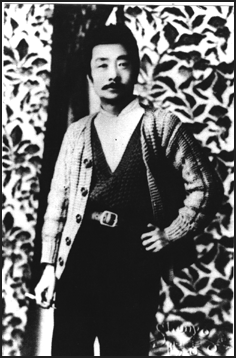
Lu Xuan Lu Xuan Memorial Hall honors one of China's greatest contemporary literary figures and thinkers. The museum features 11,200 manuscripts and 150 precious piece belonging to Lu Xuan. His tomb is located nearby.
Jade Buddha Temple (Anyuan Road) was built in 1882 and covers 8,000 square meters. It contains two jade Buddhas (a reclining one and a seated one), both brought over from Burma. The seated Buddha is carved out of a single piece of white jade. It weighs one ton and is inlaid with dazzling jewels. The temple also contains a number of rare paintings, ancient sculptures and Buddhist scriptures. In the temple the Buddha is venerated by 18 Loban, each associated with a particular Buddhist virtue. See the reclining Buddha. Enjoy a Vegetarian Lunch on site.
Grand View Garden (near Dianshan Lake) is a classical garden modeled on a similar garden in the classic Chinese novel "A Dream of Red Mansions." The eight hectare gardens have elegance and lyrical beauty and many of the buildings are modeled on lodgings of the characters in the book.
Yichuan Park is where people bring their pet songbirds and hang them in cages from trees. Located in heart of congested part of city, it is near side streets with flapping landry hanging like flags on bamboo pole, sidewalks with dentists, chamber pot collectors and vendors selling balls of rice wrapped in bamboo leaves.
Other Sights in Shanghaiinclude the Residence of Sun Yatsen, Shanghai Film Studio, the Children's Palace, the Shanghai Puppet Theater, the Shanghai Industrial Exhibition, Temple of the Town Gods, Garden of the Purple Clouds of Autumn, Long Hua temple, Xi Jiao Park and the Jin Jiang Club which used to house the French colonial club.
See Separate Articles: ENTERTAINMENT IN SHANGHAI factsanddetails.com ; MUSEUMS IN SHANGHAI: SHANGHAI MUSEUM, NEW ART MUSEUMS AND OFF-BEAT MUSEUMS factsanddetails.com PUDONG AND SKYSCRAPERS AND FAST ELEVATORS IN SHANGHAI factsanddetails.com
Old Buildings in Shanghai
Old Buildings that have not been destroyed include the mansion on Ruijun Road, where Chiang Kai-sek married Soong Mayling and the former home of gangster Big Ears Du on 182 Ninghai Xi Road (occupied in 2000 by a tool factory).
Shanghai has more Art Deco buildings than any other city in the world. In eastern Shanghai are the remains of the original walled city. Now called Nashi, it features some rebuilt Qing dynasty buildings around the Temple of the City God and Yu Yuan Gardens. Here you can find narrow twisting lanes lined with shops with upturned roofs and traditional Chinese eaves.
It is also worth walking through the old neighborhoods with longs, or lanes, lined with “shikumen”, an architectural style that combines European and Shanghainese styles. Shikumen means "tsine-framed door." Most of the shinkumen homes were originally owned by middle-class Chinese, who moved to Shanghai in the late 19th-century to escape the chaos of the Taiping Rebellion. There is a large shikumen district south of Huai Hai Dong Road and to the west of Xizang Nan Road. The government plans to level these neighborhoods to make room for new office buildings.
Suzhou Creek is one of the few places in Shanghai where you still find a reasonable number of colonial mansions. Most of are on the north side of the creek. The creek itself looks like a canal filled with fetid water. The small barges that ply it waters are low slung so they can pass under the scores of bridges hang low over the water. St. Ignatius Cathedral is a century-old church that comfortably seats 2,000. Even so, the four Sunday masses that are held are usually standing room only.
The Bund
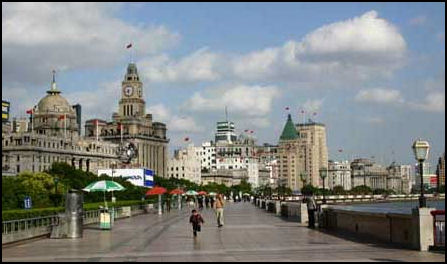
The Bund is Shanghai’s — and arguably China’s — most famous street. Populated by the beautiful Art Deco buildings of the European, British and American banks that settled here in the 1930s, the Bund is the best way to experience the city’s colonial past. Situated on the Huangpu River and running from Suzhou Creek to Shanghai Harbour Passenger Terminal, the Bund was described by one travel writer as Trafalgar Square without Nelson and the pigeons. There is something happening on the Bund every moment of the day; from locals doing tai chi in the early morning mist to families parading along the strip under the neon lights at night.
David Devoss wrote in Smithsonian magazine: “The center of old Shanghai was known as the Bund, a mile-long stretch of banks, insurance companies and trading houses on the western bank of the Huangpu. For more than a century, the Bund boasted the most famous skyline east of Suez. Bookended by the British consulate and the Shanghai Club, where foreign entrepreneurs sat ranked by their wealth along a 110-foot-long bar, the Bund’s granite and marble buildings evoked Western power and permanence. A pair of bronze lions guarded the Hongkong and Shanghai Bank building. The bell tower atop the Customs House resembled Big Ben. Its clock, nicknamed “Big Ching,” struck the Westminster chime on the quarter-hour.” [Source: David Devoss, Smithsonian magazine, November 2011]
The Bund is now officially called Zhong Shan Road. On the east side is the Huangpo river and to the west is downtown Shanghai. Strolling on the elevated waterfront walkway on the Bund is a must. The Bund has some interesting new art galleries, including one for modern art housed in the century-old former Union Assurance Company building. with in a dramatic atrium-like space designed by architect Michael Graves.
Colonial Buildings on The Bund
The Bund its known for its monumental European-style buildings built mostly in the 1920s and carefully renovated and preserved. Showcasing architectural styles ranging from neo-classical to imitation Renaissance, the buildings have massive pillars, domes, heavy facades, and clock towers. Among the most well-known ones are the sumptuous Headquarters of the Municipal People's Government, the former Bank of Hong Kong and Shanghai, the Clock Tower and the Friendship Store.
David Devoss wrote in Smithsonian magazine: The Bund “has been restored to its original Beaux-Arts grandeur. The Astor House, where plaques commemorate Ulysses S. Grant’s post-presidential visit, and where Charlie Chaplin and Paulette Goddard were summoned to dinner by liveried butlers bearing golden trumpets, is once again receiving guests. Across Suzhou Creek, the Peace Hotel (known as the Cathay when Noel Coward wrote Private Lives there during a four-day bout with the flu in 1930) recently underwent a $73 million restoration. The Shanghai Pudong Development Bank now occupies the Hongkong and Shanghai Bank building. Bronze lions have returned to guard duty at the entrance.” [Source: David Devoss, Smithsonian magazine, November 2011]
Not many of the colonial homes that once filled the neighborhoods around the Bund are left and some of it most famous buildings have been given facelifts. At the end of the Bund, for example, the former Shanghai Club, which once housed the famous 100-foot-long, the longest bar in the world, is now occupied by a two star hotel and a Kentucky Fried Chicken.
Pudong Development Bank Building
Pudong Development Bank Building (off the Bund) was once dubbed "the grandest building east of the Suez." Originally known as the Hong Kong and Shanghai Bank, it opened in 1923 and was designed by architects who were given the instructions: "Spare no expense but dominate the Bund."
The building reopened it bronze doors for business on June 9, 1998. The Hong Kong and Shanghai Bank was given first dibs on the building but they couldn't afford it. The Pudong Development Bank paid $400 million for the privilege of occupying it. .
The interior features marble floors and pillars and ornate light fixtures. Within the cupola at the entranceway are eight small paintings, representing the eight cities where the Hong Kong and Shanghai Bank had offices in 1921: Hong Kong. London, New York, Calcutta, Paris, Tokyo, Shanghai and Bangkok. In the lobby is a ceiling mosaic of Shanghai as it looked in 1923. The mosaic was covered by plaster during the Cultural Revolution and was rediscovered during renovations in mid-1990s.
Peace Hotel
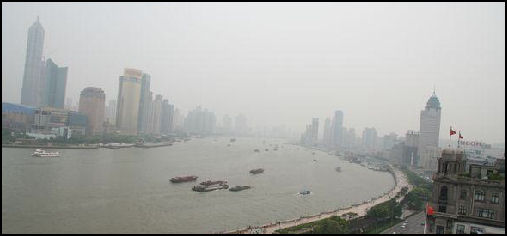
View from Peace Hotel
Peace Hotel (off the Bund), originally known as the Cathay, was one the world's most luxurious, art deco hotels during the 1930s. Opened in 1929 and owned by Iraqi Jewish tycoon Victor Sasoon, who lived in the penthouse, it was THE place to stay in Shanghai in Shanghai’s heyday. Guests included Charlie Chaplin and Noel Coward, who reportedly completed his most well known play, “Private Lives”, here in three days while recovering from the flu in 1930. Vicky Baun also set “Shanghai '37" here. In 1949, when both the Kuomintang and Communist converged on the hotel, peasant soldiers who never been exposed to modern technology washed rice in the toilets, played with the elevators and dumped fire wood and tied up their mules in the lobby.
In August 1937 the parties came to an end when two Japanese bombs exploded outside its doors, though the hotel managed to remain open until 1941. During the Chinese Civil War the hotel was occupied at different times by Communist and Nationalist forces. It reopened in 1956 as the Peace Hotel to host a visiting Soviet delegation. During the Cultural Revolution, new ceiling were quickly installed to mask imperialist symbols from rampaging Red Guards. In the 1980s, marble fixtures were removed to “freshen up” the hotel.
The old Jazz Bar within the hotel is one of Shanghai's most famous night spots. Resembling the inside of a mock medieval castle, it is decorated with a barrel-vaulted ceiling and stone pillars. Every night, the bar's legendary Old Jazz Band, a sextet made up of men in their seventies, plays tunes such as “Lili Marlene” (a song made famous by Marlene Dietrich) and “My Happiness”. The Old Band also plays in the lobby.
If nothing else stop by and check out the Art-Deco lamps, brass doorplates, chandeliers and decorated mirrors in the lobby. Make sure to look for the bats on the ceiling of the Dragon-Phoenix Restaurant and check out of the view. The ballroom floor on the eighth floor has springs beneath it. There is great view of the Bund, the river and the city from the rooftop garden. You can also visit the room of the hotel's former owner, Victor Sassoon, who made his fortune selling arms and trading opium.
War, revolution and poor renovations took their toll on the Peace Hotel. In 2008 and 2009, the hotel underwent a quick $73 million renovation — orchestrated by Hirsh Bedner Associates who has restored other famed luxury hotels like the Savoy in London — to get it in shape for the World Expo.
Other Interesting Old Hotels include the 270-foot-high Park Hotel, the tallest building in Asia until 1926; the Pacific Hotel, a granite building with a lobby that one writer said "could pass as an art deco museum," and doormen dressed in uniforms that call to mind 18th-century admirals.
Great World Amusement Center
Great World Amusement Center (south of People’s Square, Metro Line 8, Dashijie Station, Metro Lines 1, 2 and 8, People's Square Station) was once a six-story adult entertainment complex with gambling halls, opium dens, brothels, singsong girls, acrobats, magicians, and slot machines. The prostitutes wore increasingly skimpier outfits he higher one climbed. and there was special place on the roof where gamblers who had lost everything could leap to their death. For a while the building was the home of the Shanghai Youth Palace and a Guinness book of records display. .
Great World, its modern incarnation, is an amusement arcade and entertainment complex originally built in 1917 on the corner of Avenue Edward VII (now Yan'an Road) and Yu Ya Ching Road (now Middle Xizang Road). It was the first and for a long time the most popular indoor amusement arcade in Shanghai and was called the “No. 1 Entertainment Venue in the Far East.” Some traditional styles of entertainment remain but it is main occupied today by modern forms of entertainment and electronic media as well as shops, souvenir stands, food stalls,. The facility was closed in 2003 during the SARS outbreak and reopened at its centennial after repairs, in March 2017. [Source: Wikipedia]
Founded by Shanghai magnate Huang Chujiu, The Great World was built as an integrated entertainment complex featuring amusement arcades, parlour games, music hall shows, variety shows and traditional Chinese theatre. It was rebuilt in 1928 in an eclectic style borrowing largely from European baroque, topped by a distinctive four-storey tower which quickly became a landmark.
On his visit in the mid-1930s, Hollywood film director Josef von Sternberg wrote: "On the first floor were gaming tables, singsong girls, magicians, pick-pockets, slot machines, fireworks, birdcages, fans, stick incense, acrobats, and ginger. One flight up were… actors, crickets and cages, pimps, midwives, barbers, and earwax extractors. The third floor had jugglers, herb medicines, ice cream parlors, a new bevy of girls, their high collared gowns slit to reveal their hips, and (as a) novelty, several rows of exposed (Western) toilets. The fourth floor had shooting galleries, fan-tan tables, … massage benches, … dried fish and intestines, and dance platforms. The fifth floor featured girls with dresses slit to the armpits, a stuffed whale, storytellers, balloons, peep shows, masks, a mirror maze, two love letter booths with scribes who guaranteed results, rubber goods, and a temple filled with ferocious gods and joss sticks. On the top floor and roof of that house of multiple joys a jumble of tightrope walkers slithered back and forth, and there were seesaws, Chinese checkers, mahjongg, … firecrackers, lottery tickets, and marriage brokers."
On August 14, 1937, it was the site of the Great World bombing, or "Black Saturday". During the second day of the Battle of Shanghai between Chinese and Japanese force, Great World opened its doors to refugees fleeing the fighting and then was accidently struck by two bombs from a damaged Republic of China Air Force bomber that trying to release the release the bombs into the largely- uninhabited nearby Shanghai Race Course, but released the bombs too early. About 2,000 people were killed or injured. After the Communist takeover of Shanghai in 1949, Great World was renamed "People's Amusement Arcade", but reverted to the old name in 1958. Closed during the Cultural Revolution, in 1974 the site became the "Shanghai Youth Palace". In 1981, Great World was re-opened as the "Great World Entertainment Centre".
The Great World consists of three four-storey buildings and two annexe buildings. The basic layout of the complex has remained the same since 1928 rebuilding. While the entertainment options have been updated over the years — with motion pictures, for example, being replaced by karaokes — many features remain the same. One legendary feature is the twelve distorting "magic mirrors" imported from the Netherlands that have amused visitors for more than a century. There is also a theater, music hall, Guinness hall, movie hall, video hall, magic world, dancing hall, KTV, tea house, ski field, the new Shanghai flavor snack corridor, restaurant and boutique market. Throughout the day there one can enjoy entertainment, performances, viewing, food and games.
French Concession
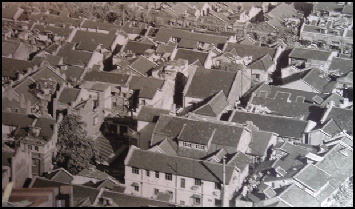
shikumen in the 1920s
French Concession (off Nanjing Road around Huaihai Lu and the Jinjiang Hotel) is the largest area of intact buildings from the 1920s and 1930s. Few of the people that lived here were French although many of the brothel customers were. Most of the residents were Chinese and white Russians. Cafes and tailor shops are housed in many of the old buildings.
The French Concession features tree-lined streets with two-story, gray-brick houses that have stone arches for doorways and terra-cotta tile roofs. Running off the main streets are narrow alleys filled with hanging laundry and lampposts. After 1949, the houses were turned into communal dwellings with, in some cases, 10 families occupying a space formally used by one family. The Russian Orthodox Mission Church built in 1931 has three blue domes. Today it houses a securities firm and a disco. Among the dignified houses are stone sidewalks, parks and plane trees.
Number One Department Store (off Nanjing Road) has traditionally been one of the busiest stores in China. In its heyday Over 200,000 customers wandered through its five floors on Sundays, buying White Rabbit sweets, Spring Thunder radios and find hard-to-find products like single replacement socks and fire hoses, and hundreds of million of dollars changed hands each year. Popular items include calligraphy brushes, 16 different sizes of thermos, bicycles, TVs and sewing machines. For a long time the demand for these items was so great you needed a ration card to buy them.
Jewish Shanghai
Jewish Shanghai (a few hundred yards from the Huangpu River) is located in the low-rent Hongko district. Some European-style row houses, a theater, a synagogue and several grand buildings are all that remain from the Jewish ghetto. The Ohel Moishe Synagogue is under the wing of the Shanghai Academy of Social Sciences and is currently known by the name the Jewish Refugee Memorial Hall. Its walls are decorated with photographs from the days when the Jewish community was a central part of cosmopolitan Shanghai. The tourist potential of the neighborhood is in the process of being explored and developed. See Minorities, Minorities in China,
Barbara Demick wrote in the Los Angeles Times: “The old Jewish quarter is in a quaintly ramshackle neighborhood called Hongkou with red-and-gray brick houses, many of them with patterned gables and fluted turrets, a weird fusion of Asian and European architecture that is uniquely Shanghai. So many Jews were here, along with cafes, cabarets, German bakeries, delicatessens, dance halls and music conservatories, that the neighborhood was nicknamed Little Vienna at the time. [Source: Barbara Demick, Los Angeles Times, September 18, 2012]
The plaque with a Star of David. And text in English, Mandarin and Hebrew sits on a brick building amid many low-rise, dilapidated buildings in the neighbourhood of Tilanqiao near Huoshan Park. It is easy to miss and even many locals are not aware of it. Ronan O'Connell of the BBC wrote: These days, Tilanqiao is a decidedly Chinese neighbourhood with hardly any foreign residents. Huoshan Park is a small and serene green space with paths that wound through lush vegetation. A group of elderly Chinese men sitting on benches watched me with puzzled expressions as I photographed the plaque. While Tilanqiao's Jewish history does attract a trickle of international visitors, this area remains well off the city's main tourist trail. [Source: Ronan O'Connell, BBC, April 5, 2021]

Historical marker in the Shanghai Jewish ghetto
“The story of this unlikely Jewish ghetto has not faded, thanks to the Shanghai Jewish Refugees Museum, housed on the grounds of the Ohel Moshe Synagogue. This Jewish place of worship acted as a community hub of Tilanqiao during World War Two. Then in 2007 it was converted into a museum, which re-opened in December 2020 after a major extension and is dedicated to preserving the little-known story of how Shanghai acted as “a modern-day Noah's Ark" for Jews, as it says on its website. in the neighbourhood of Tilanqiao.
The synagogue's prayer hall serves as the museum's entry point, and has not been altered since it was in regular use. Exhibits show how Tilanqiao's Jewish community formed, as well as intimate personal tales of Jewish refugees, according to Sophia Tian, the director of the museum's Exhibition and Research Department. The museum also encourages independent walking tours of the Jewish ghetto by providing detailed booklets that explain and map out the historical Jewish sites of Tilanqiao, which are signposted in English. Wandering its streets allowed me to imagine how Tilanqiao must have looked 80 years ago as Japanese troops swarmed Shanghai.
The first structure I came across was the imposing old Tilanqiao Prison. During World War Two, the Japanese incarcerated dozens of Jewish refugees and Chinese dissidents behind its thick stone walls. Next, on Changyang Road, I passed one of the former Jewish refugee shelters. Now operating mostly as apartments, these seven multi-storey buildings housed more than 3,000 Jewish people in the early 1940s. Nearby, the area along Huoshan and Zhoushan roads was once known as Little Vienna, and was the most prosperous part of Tilanqiao's Jewish neighbourhood. In the late 1930s, those streets were the backbone of Shanghai's Jewish community, and brimmed with Jewish businesses and regular social events at the Mascot Roof Garden atop the former Broadway Theatre. That graceful art deco building, which now operates as a small hotel, was a source of joy for the city's Jews prior to World War Two.
See Separate Articles JEWS IN CHINA: THEIR HISTORY, COMMUNITIES AND HELPING THEM IN WORLD WAR II factsanddetails.com JEWS AND JEWISH CULTURE IN CHINA TODAY factsanddetails.com
Moller Villa
Moller Villa (in the French Concession) is one of Shanghai's architectural marvels. Wang Zhiyong wrote in China.org: “Of Shanghai's many colonial-era mansions, the Moller Villa on the northwestern edge of the French Concession stands out with its fantasy of brown-tiled Gothic and Tudor steeples, gables, and spires. It was built by a Swedish shipping magnate, Eric Moller, in 1936. Legend has it that Jewish Eric Moller came to Shanghai in 1919 empty-handed and made his fortune here by winning large sums at the horse races, culminating in the construction of this fantasy home for his daughter. The daughter is said to have had a dream in which she saw a castle like those in the Hans Andersen fairy tales. On awakening, she drew a sketch. The father was so fond of his youngest daughter that he immediately commissioned an architect to build her dream house. [Source: Wang Zhiyong, China.org, May 20, 2009]
“Looking at the Gothic fantasy, unique in comparison to other old buildings in the French Concession, the tale seems so convincing. An oval railing fence on the third floor signifies a shipping theme in the Moller Villa's architectural detailing. But, as it turns out, it is as fantastic as the villa. Tina Kanagaratnam from the local newspaper Shanghai Daily has documented the truth about the house. Architectural historian Tess Johnston, the co-author of A Last Look: Western Architecture in Old Shanghai met Moller's daughter in the summer of 1992, and reported that she "stated categorically that there was not a shred of truth" in the tale.
“The decorative round windows by the stairs, the sealing windows, and an oval railing fence on the third floor reminiscent of a steering cabin; all signify a shipping theme in the architectural detailing. Besides its Scandinavian features, there are some Chinese touches. The enclosing walls had Chinese glazed tiles at the top. Two stone lions stood at the front gate. Inside were Chinese designs and patterns and many Chinese antiques.
“For more than half a century, the Moller Mansion served as the headquarters of the Communist Youth League Shanghai Branch. In 1989, the Villa was listed as one of Shanghai's protected historical buildings. In 2001, the local Hengshan Group took it over and restored the original mansion, added several garish imitation buildings in the back, and reopened it all as a hotel in May 2002.
In 2006, the hotel was ostensibly "closed for repairs" while in fact being used as the headquarters of a corruption investigation into Shanghai's top official, Party Secretary Chen Liangyu. It was said that the fairyland villa turned into a nightmare for many corrupt officials who thought that they had been invited there for a "cup of coffee". The villa hotel did not reopen to guests until April 2009. Location: Shaanxi Nan Lu 30, Shanghai, South side of Yan'an Zhong Lu; ten minutes walking from two nearby subway stations. Tel: 021-62478881 Website: mollervilla.com in Chinese, click Google translate
Eric Moller, the Man Behind Moller Villa
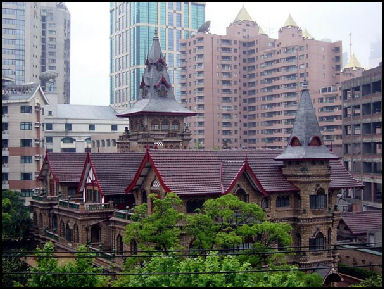
Moller Villa Wang Zhiyong wrote in China.org: “The Mollers were originally Swedish with British citizenship. Eric Moller was the son of wealthy businessman Nils Moller, who had started a business in Hong Kong in the 1860s. The business grew and expanded into eight cities in China, and although the Mollers left Shanghai in 1950, their companies continued operating in Hong Kong into the 1990s. The core of the family business was shipping and shipbuilding, and in Shanghai, the Moller portfolio included shipping lines, insurance, real estate and investment. In 1913, Eric Moller took over the family business and prospered. He had a steamboat that ran between Shanghai and Zhenjiang in Jiangsu Province, and, in the mid-1920s, decided to embark on the construction of a house for his big family — six children and a menagerie of dogs and cats. In 1927, a Shanghai architectural firm, Allied Architects, delivered the blueprint, and the house was essentially finished in 1936. The combination of a distinctly Scandinavian style with architectural references to ships throughout the house hints that Moller was probably heavily involved in the design. [Source: Wang Zhiyong, China.org, May 20, 2009]
“Moller was a horseracing fan and the chair of the Shanghai Horse Racing Club. His beloved horse Blonic Hill, an Arab stud stallion, brought him money and honor in the racing field. In memory of his horse, Moller built a tomb to Blonic Hill that stood on the lawn of the garden. Now only the bronze statue of the horse remains. Later, after the funeral of the horse, the family's dogs and cats joined the statuary. The story is that there was another bronze dog but it was lost during the Cultural Revolution (1966-1976).We did find a stone dog in the garden, and the hotel manager told us it was the very dog that Moller had raised.
“It was said that a fortune-teller told Moller that if he ever finished the house, ill-fortune would befall him. So Moller dawdled, adding bits and bobs for more than 10 years, finally completing the task in the late 1940s. According to Johnston, Moller's daughter said that the fortune-teller tale too is false, but there is no doubt that Moller's fortunes took a turn for the worse following the breakout of World War II. During the Pacific War, the house was occupied by the Japanese. Later, it housed a Kuomintang espionage agency. However, a picture in the villa hotel shows Eric Moller and his employees in a peaceful gathering in front of the Fairytale House in 1947, which left me puzzled.
“Moller left Shanghai in 1950 soon after the communists came to power. A few years later on a flight to Singapore, as his daughter Nancy watched and waited for him at Singapore's Kallang Airport, his Qantas plane crashed on landing, killing Eric Moller and 32 other passengers. According to Johnston, his elder sons Eric Jr and Ralph took over their father's business after he died. The interest in horses continued in the next generation, and they owned a successful stud farm, White Lodge Stud, in Newmarket in England.
According to an office employee who once worked here with the Communist Youth League, Moller's daughter visited the house twice after China's opening up. She was refused entry on the first occasion and was only able to take a walk in the garden, but she was allowed into the house on the second visit. It was said that she wept in her own bedroom on seeing that everything had been preserved as it was. But she never again returned to the house.
Places near Shanghai
Chongming Island (one hour from Shanghai) has been called the “Shangri-La of Shanghai” and the “last virgin island” in Yangtze. These days developers are quite excited about developing it after it was linked to the mainland by a new bridge that opened in October 2009. Fifty percent larger than Singapore, Chongming island is home to 700,000 people put is expected to grow to 2 million people by 2020. On the drawing boards are a Disney theme park, a replica of Michael Jackson’s Neverland ranch and the “eco-city” of Dongtan, designed by a British firm. Before the bridge was built residents relied on 18 ferry routes to get them to the mainland. Two more bridges are planned.
Putuoshan (accessible from Shanghai, on a two-hours fast boat, 14-hour slow boat and from Ningbo) is a small island with a quiet unspoiled atmosphere, green rolling hills, nice beaches, and Buddhist temples. See Ningpo below. Web Site: Lonely Planet Zhujiajiao and Zboushi are ancient river towns located in the vicinity of Dianshan Lake. Here you will find water and bridges everywhere. Boats pass right underneath the eaves of houses. Thames Town (an hour from Shanghai in the suburb if Songjang) is an imitation English town complete with a pub, fish-and-chips shop, neo-Gothic church, Georgian- and Victorian-style terraced houses, English gardens and even a bronze statue of Winston Churchill. The town is part of $635 million development expected to house 10,000 people.
Image Sources: 1) CNTO (China National Tourist Organization; 2) Nolls China Web site; 3) Perrochon photo site; 4) Beifan.com; 5) developers, architecture firms, tourist and government offices linked with the place shown; 6) Mongabey.com; 7) University of Washington, Purdue University, Ohio State University; 8) UNESCO; 9) Wikipedia; 10) Expo Pictures, official Shanghai Expo website
Text Sources: CNTO (China National Tourist Organization), UNESCO, Lonely Planet guides, New York Times, Washington Post, Los Angeles Times, National Geographic, The New Yorker, Time, Newsweek, Bloomberg, Reuters, Associated Press, AFP, Compton's Encyclopedia and various books and other publications.
Updated in May 2020
